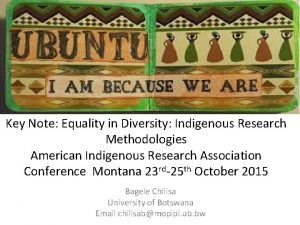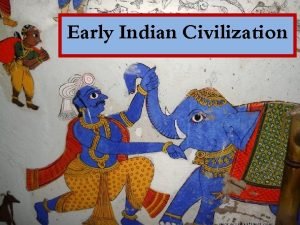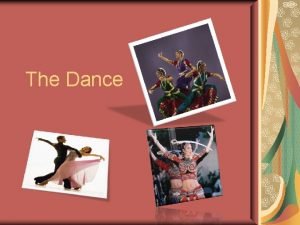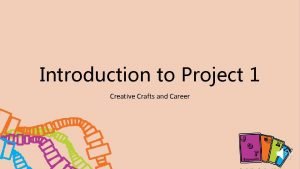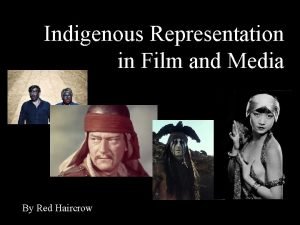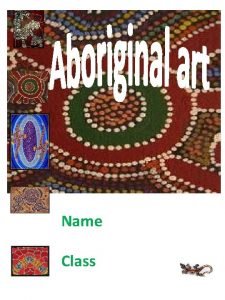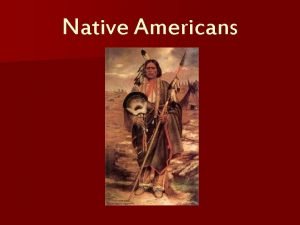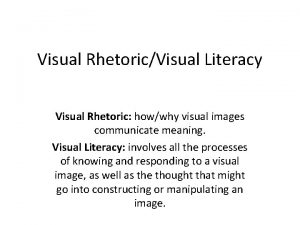Essential question Howwhy do indigenous Americans use the




















































- Slides: 52


Essential question How/why do indigenous Americans use the natural environment to create works of art?

Local products are going to form the basis of most north American art forms; wood in the PNW; plant fibers, wool and clay in the American SW; hided in areas dominated by bison and deer.

Geometric designs on ceramics and other utilitarian objects Highly decorated fabrics with beading and weaving mark their art.

As the influence of European settlers spread throughout North America, native artists were keen to adapt their traditional forms to new media and new markets.

Europeans had an appetite for native art forms and acted as collectors and patrons for works that appealed to them. Native American artists like Cadzi Cody and Maria Martinez began serving an emerging tourist industry that appreciated their artistry

Ask yourself. . . 1. What is the specific geographic and cultural context in which the work was created? 2. What does the imagery symbolize? 3. To what extent did European contact change the materials and imagery used by Native American artists? 4. Which of these works do not demonstrate influence of European contact? Why? 5. Which were created for a tourist audience? How can you tell?

163. Bandolier Bag Lenape (Delaware Tribe) 1850 CE Beadwork on Leather


• Bandolier Bags are based on bags carried by European soldiers armed with rifles, who used the bags to store ammunition cartridges.

• Ojibwe language they are called Aazhooningwa'on, or • “worn across the shoulder” • Made by different tribes across the Great Lakes and Prairie regions. Differences in appearance & style are the result of personal preference and contact with Europeans and Euro-Americans, goods acquired in trade, and travel. While men most commonly wore these bags, women created them Beads and other materials were embroidered on the trade cloth and hide. The tiny glass beads, called seed beads, were acquired from European traders along with silk ribbons, and these were prized for their brilliant colors


• The designs on the bag are abstracted and symmetrical. White beads act as contour lines to help make the designs more visible to the naked eye





Form Function Content Context bright colors, geometric designs made for women, as they were objects of prestige has a large heavily beaded pouch with a slit on top. bag held at hip level; strap across the chest; made of leather, cotton or wool functional as a bag, but also beautiful bead work not in in the Americas before European contact beads imported from Europe

164. Transformation Mask Kwakwaka’wakw NW coast of Canada 1890 Wood

164. Transformation Mask Kwakwaka’wakw NW coast of Canada, 1890, Wood



• Masks passed between family members of a specific clan (they could be inherited or gifted) • They were just one sign of a person’s status and rank, which were important to demonstrate within Kwakwaka’wakw society • A Potlatch was an opulent ceremonial feast at which possessions are given away or destroyed to display wealth or enhance prestige. Transformation masks were a central part to these rituals


• Potlatches were banned in 1885 until the 1950 s because they were considered immoral by Christian missionaries who believed cannibalism occurred (for its part, the Canadian Government thought potlatches hindered economic development because people ceased work during these ritual celebrations). With the prohibition of potlatches, many masks were confiscated. Those that weren’t destroyed often made their way into museums or private collections. When the ban against potlatches was removed by the Canadian government, many First Nations have attempted to regain possession of the masks and other objects that had been taken from them. Potlatches are still practiced today among Northwest Coast peoples.



Form Function Content Context Large wooden mask that opens to reveal a human face; draped with raffia, to hide the shoulders of the wearer worn over the head as part of a complete body costume bird head exterior opens to reveal a human face on the inside masks worn by native people of the Pacific Northwest, western Canada, Alaska At the moment of transformation, the performer turns his back to the audience to conceal the action and heighten the mystery During the ritual performance, the wearer opens and closes the transformation mask using string

165. Painted Elk Hide attributed to Cotsiogo Eastern Shoshone 1890 CE Painted Elk Hide

Painting on animal hides is a longstanding tradition of the Great Basin and Great Plains people of the United States This would include the Kiowa, Lakota, Shoshone, Blackfeet, Crow, Dakota, and Osage. While the earliest surviving hide paintings date to around 1800, this tradition was undoubtedly practiced much earlier along with other forms of painting like petroglyphs (rock engravings). Painting, in tandem with oral traditions, functioned to record history. Artists decorated the hides with geometric or figural motifs. By the later nineteenth century certain hide artists began depicting subject matter that “affirmed native identity” and appealed to tourists. The imagery placed on the hide was likely done with a combination of free-hand painting and stenciling.

165. Painted Elk Hide attributed to Cotsiogo Eastern Shoshone 1890 CE Painted Elk Hide Men and women both painted on hides, but men usually produced the scenes on tipis (tepees), clothing, and shields. Many of these scenes celebrated battles and other biographical details.


Cotsiogo Eastern Shoshone; pronounced “co SEE ko” Also known by his Euro-American name, Cadzi Cody A member of the Eastern Shoshone tribe Painted on elk, deer, or buffalo hides using natural pigments like red ochre and chalk, and eventually paints and dyes obtained through trade


Cotsiogo was placed on the Wind River Reservation in central western Wyoming. The Wind River Reservation is the size of Rhode Island Delaware combined and had been established by the Fort Bridger Treaty of 1868. Prior to their placement on the Wind River Reservation, the Shoshone moved with the seasons and the availability of natural resources.

Form Function Content Context Traditional: Worn over the shoulders of a warrior as a robe Traditional: Warrior’s deeds are celebrated on the hides; convey biographical information: personal accomplishments, heroism and battles men painted the hides to narrate an event Later: Eventually painted hides for European/ American markets Later: depicted traditional aspects of the Plains People culture that were nostalgic rather than practical eg- bison hunt with bow and arrow; nomadic hunting was gone and bison nearly extinct Bison considered to be gifts from the Creator; horses in common use by 1750 Depicts a Sun dance- around the head of bison (outlawed by the US gov’t); Sun Dance: men dance, others sing, prepare the feast, teepees- made of hide stretched over poles; the exterior poles were meant to reach the sky or the spirit world

166. Black-on-black ceramic vessel Maria Martinez and Julian Martinez Pueblo, New Mexico, 1950 CE, Blackware ceramic

Maria Martinez 1887 -1980 Pueblo of San Ildefonso, about 20 miles north of Santa Fe, New Mexico one of the best-known Native potters of the twentieth century Know as an excellent ceramic craftswoman and for her connections with a larger, predominantly non-Native audience. Before the arrival of the railroad to the area in the 1880 s, pots were used in the Pueblos for food storage, cooking, and ceremonies Her work and her life had a wide reaching importance to the Native art world by reframing Native ceramics as a fine art.


Maria Martinez Even at a young age Maria was noted for being a skilled potter She learned techniques that were used in the southwest for several millennia All of the raw materials for her pottery are gathered locally and carefully processed by the community – They make their own clay!


Making ceramics in the Pueblo was considered a communal activity, where different steps in the process were often shared. The potters helped each other with the arduous tasks such as mixing the paints and polishing the slip.

What do you think her ceramics are worth?


Helping her Pueblo (community) was of extremely important to Ms. Martinez. She lived as a proper Pueblo woman, avoiding self-aggrandizement and insisting to scholars that she was just a wife and mother even as her reputation in the outside world increased. To help other potters in the Pueblo, Ms. Martinez was known to have signed the pots of others, lending her name to help the community…. What do you think of that? Is that okay?







Form Function Content Context Black on black; highly polished surfaces; Sparks a revival of Pueblo techniques Exceptional symmetry; walls of even thickness; surfaces are free of imperfections Comes from the 1000 year old tradition of pottery making in the SW contrast matte and shiny black finishes At the time of production, Pueblos were in decline; modern life replacing traditional life Maria made the pots; developed/ invented more shapes than traditional pueblos used Julian painted the pots; used a revival of ancient mythic figures and designs
 Costa question
Costa question Essential non essential fatty acids
Essential non essential fatty acids Language
Language Essential question for pythagorean theorem
Essential question for pythagorean theorem Essential question generator
Essential question generator Pythagorean theorem essential questions
Pythagorean theorem essential questions Essential question for figurative language
Essential question for figurative language Individual vs society
Individual vs society Context clues essential questions
Context clues essential questions Cornell notes essential question
Cornell notes essential question Asking essential questions
Asking essential questions Essential questions for multiplication
Essential questions for multiplication Essential question gif
Essential question gif External and internal character traits
External and internal character traits Essential question cornell notes
Essential question cornell notes Short story essential questions
Short story essential questions Indigenous axiology
Indigenous axiology Colors of the medicine wheel
Colors of the medicine wheel Herman michell
Herman michell What is indigenous research
What is indigenous research Indigenous methodologies
Indigenous methodologies Indigenous knowledge systems tok
Indigenous knowledge systems tok Indigenous name for forced labour
Indigenous name for forced labour Indigenous aryans
Indigenous aryans World council of indigenous peoples
World council of indigenous peoples Defenition of bacteria
Defenition of bacteria Indigenous simple machines
Indigenous simple machines Ethnic religions ap human geography
Ethnic religions ap human geography What is indigenous flora
What is indigenous flora Kai aboriginal game
Kai aboriginal game Examples of indigenous crafts in the philippines
Examples of indigenous crafts in the philippines Slidetodoc.com
Slidetodoc.com Lite lincdire project
Lite lincdire project Indigenous science
Indigenous science Major indigenous settlements in tennessee
Major indigenous settlements in tennessee Introduction to indigenous creative crafts
Introduction to indigenous creative crafts Aboriginal representation in film
Aboriginal representation in film Geo indigenous alliance
Geo indigenous alliance Indigenous wellness framework
Indigenous wellness framework Bacteria defenition
Bacteria defenition Indigenous education in nigeria
Indigenous education in nigeria Indigenous banking system
Indigenous banking system Aboriginal art symbols and meanings
Aboriginal art symbols and meanings Pristinity
Pristinity Indigenous thinking in business
Indigenous thinking in business The world's largest universalizing religion is
The world's largest universalizing religion is Question words present simple
Question words present simple Highly closed question
Highly closed question Contoh open-ended question adalah
Contoh open-ended question adalah Factor isolating question example
Factor isolating question example Question direct
Question direct Supporting questions
Supporting questions Examples of compelling and supporting questions
Examples of compelling and supporting questions



















